

Site Search
Search within product
第742号 2022 (R04) .07発行
Click here for PDF version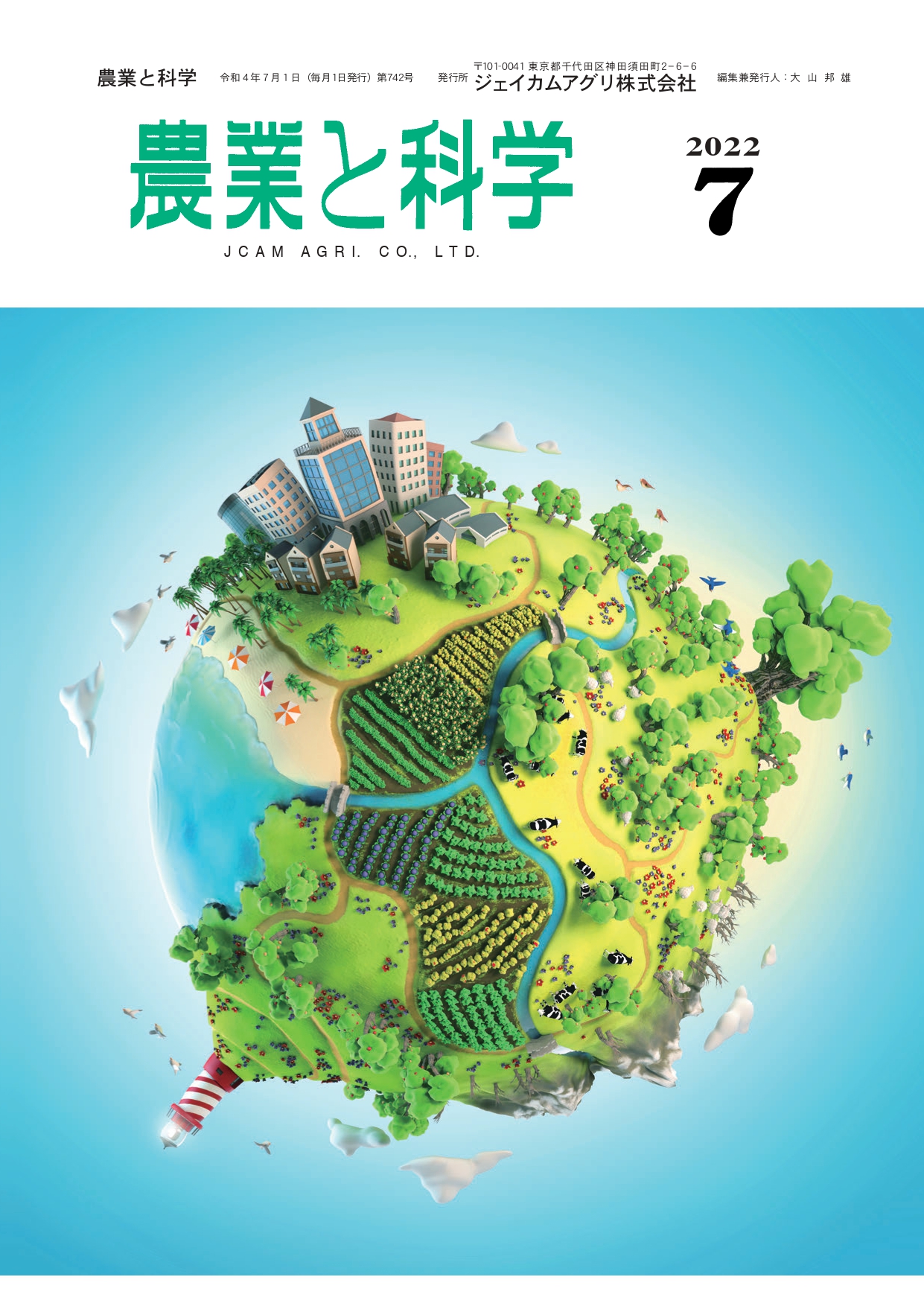
農業と科学 令和4年7月
本号の内容
§肥効調節型肥料を利用したシクラメンの省力栽培技術
Nagano Prefectural Vegetable and Flower Experiment Station, Flower Department
森野 林太郎
No § Soil - No.13
有機物資材の種類とその効果
−C/N比が要点−
Jcam Agri Co.
北海道支店 技術顧問
松中 照夫
Labor-saving cultivation technology for cyclamen using fertilizer with controlled fertilizer effect
Nagano Prefectural Vegetable and Flower Experiment Station, Flower Department
森野 林太郎
Introduction
The harvested area of cyclamen in Nagano Prefecture is 18 ha and the volume shipped is 2.21 million pots, ranking first in Japan in both area and volume (Statistics of Agriculture, Forestry and Fisheries, 2028). Figure 1 shows the trends in the harvested area and shipped quantity of cyclamen in Nagano Prefecture, with the harvested area increasing in comparison with the shipped quantity after the late 1990s. This indicates a shift in production from large pots, such as No. 6 pots, to No. 4 pots and miniature cyclamen, and an increase in the number of pots grown per grower. The labor required to apply fertilizer to cyclamen increases in proportion to the number of pots grown, making labor-saving a problem. Therefore, the use of a fertilizer with controlled fertilizing effect was studied in order to reduce the labor required for fertilizing cyclamen.
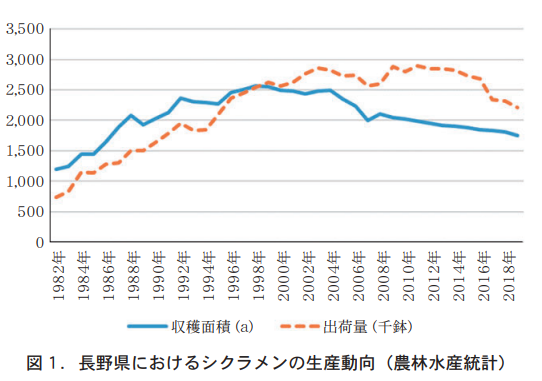
2. Testing Method
(1) Outline of cultivated species
The trials were conducted in 2019 and 2020 in a glasshouse at the Nagano Prefectural Vegetable and Flower Experiment Station (750 m altitude) in Shiojiri, Nagano Prefecture.
A. Fiscal Year 2019
The varieties tested were "ASP Pink (Izumi Noen, Ltd.)" and "Bright Red (Morel)". Seedlings of "Bright Red" were sown on January 7, 2019 and sprouted at 17-20°C in a biotron, and grown in a glasshouse heated to 15°C from February 6 onward. The seedlings were planted in No. 2.5 pots on April 16, and all test plots were fertilized with one small grain of Green Thumb D (MC Ferticom Co., Ltd.) per pot on May 15. At that time, each fertilizer (Table 1) was mixed into the medium as a basal fertilizer.

In addition, magnesium sulfate was applied to all test plots at a rate of 2 g per pot. In the conventional treatments, one small grain of Greensum D was applied per pot on July 4 and 26, and one small grain of Promix (Hyponex Japan Co., Ltd.) on August 16, September 25, and October 16, respectively. The irrigation medium was "Promix BX-J" (Innovex Co., Ltd.), and irrigation was done by bottom watering with C steel and water absorbing string. 501 TP3T of shade was applied from July 20 to September 30 from 9:00 to 16:00.
a. FY2020
The varieties tested were "ASP Pink" and "Latinia Fantasia Red (Morel)". The seedlings of "Latinia Fantasia Red" were sown on January 9, 2020, sprouted as in 2019, and grown in a glasshouse heated to 17°C from February 19 onward. Boxed seedlings of "ASP Pink" were brought in on April 15. Provisional planting was done as in 2019; one small grain of Greensome D per pot was added to all test plots on May 8 and May 26; planting in No. 4 pots, basal fertilizer, and magnesium sulfate were done as in 2019; and the seedlings were planted in No. 4 pots. In the conventional plot, one small grain of Greensum D was applied on July 2, and one small grain of Promic per pot on July 22, August 14, September 14, and October 14, respectively. The irrigation was done by hand until July 17, and thereafter by bottom watering with C steel and water absorbent string. 501 TP3T shading was applied from June 12 to July 1 and from August 1 to September 30 between 9:00 a.m. and 4:00 p.m. The irrigation rate was about 501 TP3T per pot.
(2) Composition of the test area
In order to select an effective fertilizer for cyclamen cultivation, five fertilizers were tested in FY2019: Super Ecolong 413-180, Super Ecolong 413-140, LP compound fertilizer (LPS110 + LPS140 + EcoCalicoat + Heavy Burned Phosphorus No. 2, J-Cam Agri Co. In FY2020, Super Ecolong 413-180, Super Ecolong 413-140, LP compound fertilizer (LPS110 + LPS140 + Ecokalicoat + Heavy Burned Phosphorus No. 2, JCAM Agri Co. Osmocote Standard was examined. The cultivation method without fertilizer application was also studied, following the conventional fertilizer application system (Table 2).
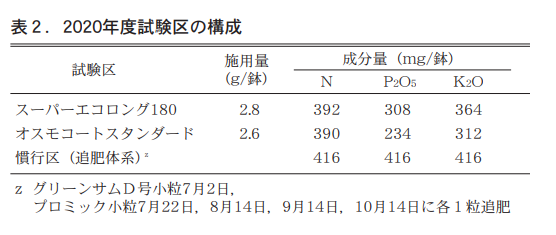
(3) Survey Method
a. Nitrogen leaching rate of regulated fertilizers
Each fertilizer was placed in a non-woven fabric and managed in the same way as the pots for the potted flower quality study, with seedlings planted in pots filled with medium only without planting in 2019 and in 2020, respectively. 94, 122, and 151 days after planting in 2020, and 14, 35, 47, 47, 62, 81, 122, and 151 days after planting in 2020, respectively. The number of replications was 2.
b. Potted flower quality survey
In 2019, surveys were conducted on October 8 (ASP Pink) and October 11 (Bright Red). Plant width was the mean of the plant's long and short diameters, plant height was the height from the pot floor to the uppermost leaf, leaf length was the length from the base of the petiole to the tip of the top three largest leaves in the pot, and leaf number was the number of leaves with a leaf length of 3 cm or greater.
In FY2020, surveys were conducted on October 16 and 28. The number of leaves was the number of leaves with a leaf length of 2 cm or more, and the number of flowers was the number of flowers that opened when the petals opened upward once a week from July 22 to September 30. All other surveys were conducted in the same manner as in 2019. Each test plot had two replications with 10 pots per plot.
Results and Discussion
(1) Selection of fertilizer with controlled fertilizer effect
Since nitrogen concentration in summer strongly affects quality at the time of shipment, a fertilizer with a low leaching rate in the early period after potting and a constant fertilizing effect thereafter is suitable.
Nitrogen leaching rates were investigated, and the results showed that the initial leaching of Super Ecolong 413-180 was suppressed compared to Type 140 and Osmocote. Super Ecolong 413-180 continued to have a similar elution rate in 2020 (Figure 2). Although the nitrogen leaching rate at the time of the final survey was low, about 501 TP3T, the fertilizer efficacy is expected to continue at the consumer stage; LPS110 and 140 showed complete suppression of initial leaching and stable fertilizer efficacy (Figure 3), but they are blended compound fertilizers, and it is difficult to apply each fertilizer grain quantitatively in each pot.
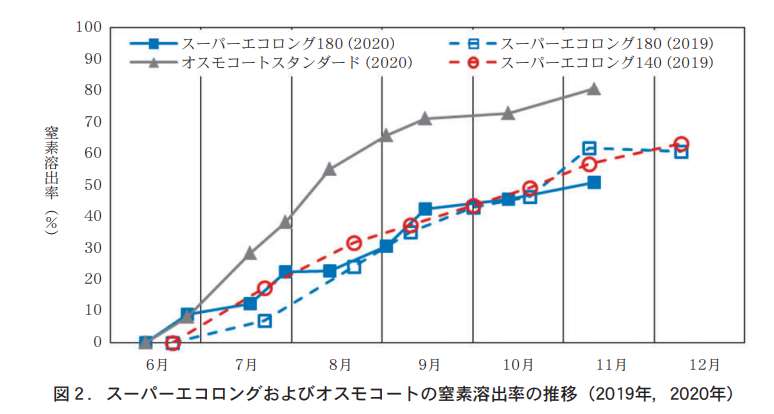
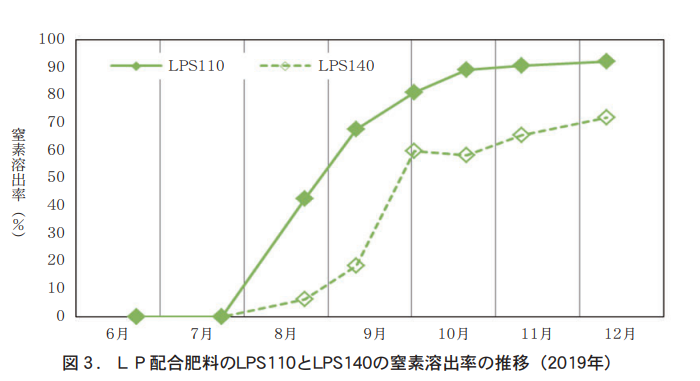
Based on these results, Super Ecolong 413-180 was considered promising because it is easy to handle, has stable initial leaching control, and is expected to remain effective during the ornamental period after shipment.
(2) Consideration of fertilizer application amount
2019年度は各種肥効調節型肥料について,施肥量の多い区と少ない区を設置した。スーパーエコロングを2g施肥した少肥区の「ブライトレッド」は,140,180のいずれのタイプも窒素欠乏の症状である葉縁の白化がわずかにみられ,生育後半に窒素が不足したと考えられる。一方,多肥区では過繁茂な生育となり,中でもスーパーエコロング,LP配合では窒素過剰により苦土欠乏の症状である褐色斑点症状が発生した(表3) 。
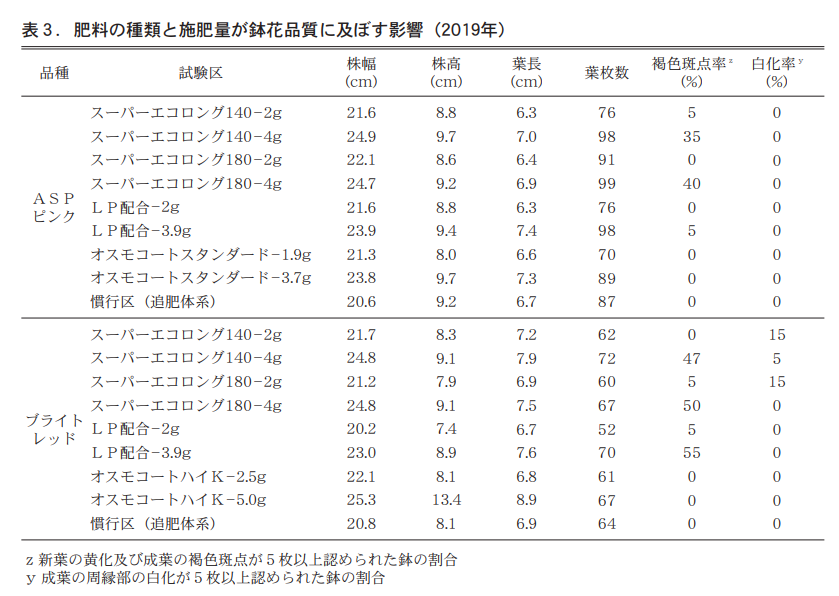
In FY2020, Super Ecolong 413-180 and Osmocote Standard, which is widely used in potted plant cultivation in the prefecture, were examined in accordance with the conventional fertilizer application system. The results showed that the quality of potted flowers and the number of blooms were good between the areas where Super Ecolong 413-180 was mixed with 2.8 g of medium and the conventional areas, and there were no significant differences between the two areas under the conventional fertilizer system (Table 4, Fig. 4, and Fig. 5).
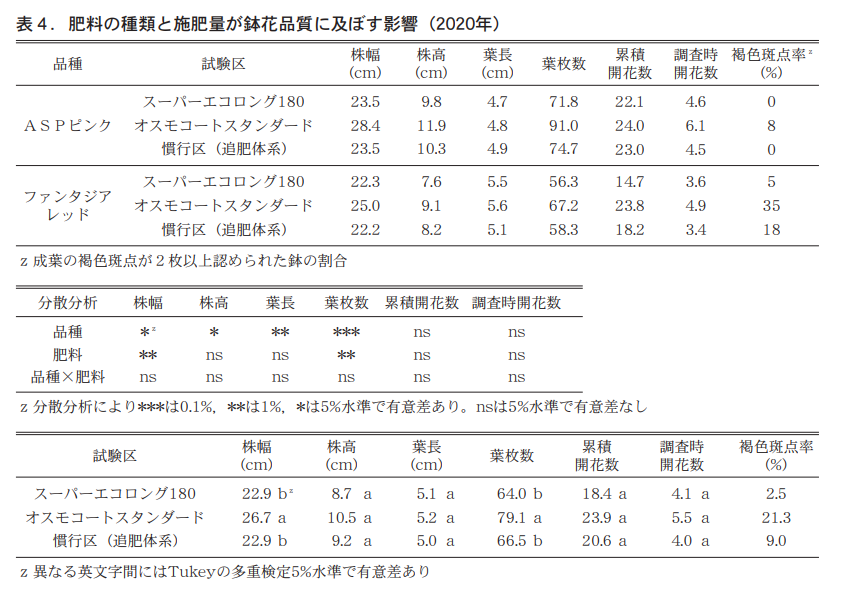
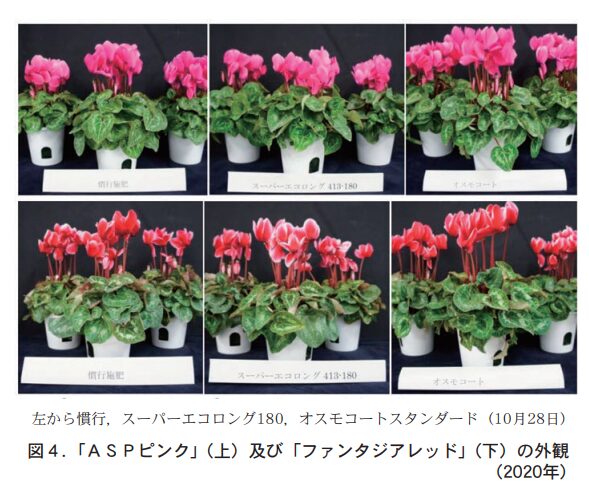
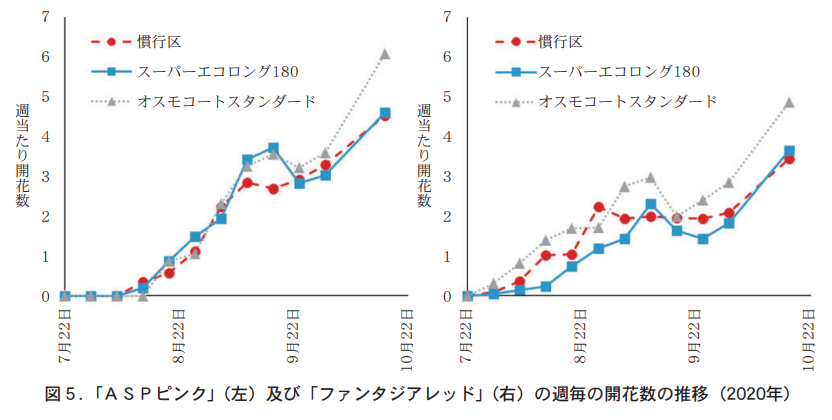
These results suggest that in cyclamen cultivation in No. 4 pots, Super Ecolong 413-180 can be applied at the time of planting to obtain potted flower quality equivalent to that of the conventional fertilizer system.
4. fertilizer application time
The time required for fertilizer application in the cultivation of cyclamen in No. 4 pots was estimated, and it was considered possible to save about 10 hours of labor per fertilizer application by using fertilizer with a controlled fertilizer effect (Table 5).
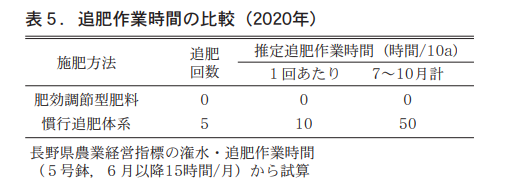
Summary
(1)シクラメンの4号鉢栽培において,肥効調節型肥料「スーパーエコロング413−180」を鉢当たり2.8g培土に混合施肥することで,その後の追肥作業を省略し,置き肥を利用した追肥体系と同程度の鉢花品質を得ることができる。
(2) This fertilizer application method reduces fertilizer application time by about 50 hours per 10a (about 15,000 pots).
(3)培土を十分に混和するなどし,鉢毎に施肥量のばらつきが生じないよう注意する必要がある。施肥量が多過ぎると品種によっては,窒素過剰による苦土欠乏(褐色斑点症状)が発生する可能性がある(長野県平成25年度技術情報「シクラメンの肥料要素欠乏・過剰施用時における特徴的な形態変化」及び平成29年度技術情報「シクラメン葉の褐変及び白化症状の発生原因」参照) 。
(4) In the future, a similar fertilization method is planned for mini cyclamen and No. 5 pots.
No Soil - 13th
有機物資材の種類とその効果
−C/N比が要点−
Jcam Agri Co.
北海道支店 技術顧問
松中 照夫
Compost was originally conceived as a material for transferring nutrients to farmland. In Japan, however, compost is now expected to be used as a stable organic matter and as a source of biological supply. Last month, we discussed the expected effects of such composts and how these expectations are reflected in crop production depending on the soil conditions.
This month, we will organize the expression of the effects of various organic materials, including compost, in terms of C/N ratio. Furthermore, in Japan, compost used is often limited to "fully matured compost. We will consider why this is so.
1. C/N ratio of organic materials and ease of decomposition
有機物資材が土に与えられると,土の微生物に分解されていく。この時,有機物資材の分解されやすさは炭素(C)と窒素(N)の比率(C/N比,炭素率ともいう)によって決まる。炭素が少なく窒素の多いC/N比が20くらいより小さい有機物資材(表1参照,ダイズかす,鶏ふん,牛ふんなど)は,土に混和されると微生物に早く分解される。このため,養分的な効果が現れやすい。つまり,養分源としての利用に適した資材である。完熟堆肥といわれるのはこのようなC/N比を持っている。しかし,分解されやすいので土に有機物として残るのはわずかしかない。それゆえ,このタイプの有機物資材には土の中で安定した有機物としての効果は期待しにくい。このため,土の物理的な性質を改善するには適当な資材とはいえない。
Conversely, organic materials with a C/N ratio higher than about 30 (see Table 1), which are high in carbon and low in nitrogen (e.g., bark compost, inawara, wheat straw, etc.), decompose slowly in the soil. For this reason, they are not expected to be very effective as nutrients. However, organic materials accumulate in the soil as relatively stable organic matter. Therefore, these materials should be used when the objective is to improve the physical properties of the soil.
Specific examples of each type of organic material and their main uses are listed in Table 1.

2. use organic materials with high C/N ratio with caution
When organic materials with a C/N ratio of 30 or higher are used, even if the purpose of their use is to improve the physical properties of the soil, they may have a negative effect on crops. After a short time of feeding this type of organic material, the crop may show symptoms of nitrogen deficiency, such as yellowish-green leaf color and growth suppression. This phenomenon is called "nitrogen starvation. This is a strange phenomenon in which crops become nitrogen-deficient despite the application of fertilizer. The mechanism by which nitrogen starvation occurs is interesting.
When organic matter with a high C/N ratio is fed to the soil and decomposed by microorganisms, carbon (C), which is a source of energy for the microorganisms, is supplied sufficiently by the organic matter. In contrast, the supply of nitrogen (N), an important protein source for microorganisms, is relatively low compared to carbon. Therefore, this material cannot meet the nitrogen requirements of the microorganisms. Therefore, microorganisms that require nitrogen take in inorganic nitrogen (nitrate nitrogen and ammonia nitrogen) that is already present in the soil or inorganic nitrogen provided as fertilizer as a nutrient source, and change its form into organic nitrogen such as their own protein (this is called the organic transformation of inorganic nitrogen). As a result, the inorganic nitrogen in the soil is transformed into a form that is difficult for crops to utilize, resulting in nitrogen deficiency diseases in crops.
3. Why is the supremacy of mature compost in our country?
As mentioned in the 11th issue of this series (May issue), in Europe, compost is traditionally regarded as a nutrient transfer material. Keeping livestock is a prerequisite for compost production, and compost is regarded as a source of nutrients itself. Therefore, as in Japan, compost is not expected to have a variety of effects, including effects as a stable organic matter and as a source of biological resources, in addition to its effect as a source of nutrients.
On the other hand, before the advent of chemical fertilizers, compost had to be used as a source of nutrients in Japan. In Japanese agriculture, however, livestock were used mainly for labor, not for compost production. Farmers kept only a small number of livestock, and there was not much livestock manure available for compost production. Most of the raw materials for composting were ina straw, wheat straw, and fallen leaves and branches from nearby satoyama, and their C/N ratios were as high as over 60. If the C/N ratio remained high, the crops would be at risk of nitrogen starvation.
During the process of rotting, the carbon contained in the material is decomposed by microorganisms under conditions of sufficient oxygen (aerobic conditions) and eventually transformed into carbon dioxide (CO2), which is released into the atmosphere. This reduces the amount of carbon contained in the raw material. On the other hand, most of the nitrogen is retained in the raw material even after the maturation process has proceeded. Therefore, the amount of nitrogen (N) does not change significantly as the rotting process proceeds, but the amount of carbon (C) decreases, resulting in a smaller C/N ratio. Fully ripened compost is compost in which the C/N ratio is reduced by rotting.
When matured compost with low C/N ratio is fed to the soil, decomposition by microorganisms proceeds quickly. With decomposition, the nitrogen contained in the compost changes from the organic form, which is difficult for crops to absorb, to the inorganic form, ammonia-form nitrogen, which is easy to absorb. This is then absorbed by the crops as nutrients. In other words, organic materials with a high C/N ratio, such as rice straw and wheat straw, are not effective as nutrients when fed to the soil unless they are sufficiently decomposed into fully matured compost.
In the absence of chemical fertilizers, compost was a valuable source of nutrients even in Japan. In order to use compost as a source of nutrients, it was essential to keep the C/N ratio low. The reason why the supremacy of fully matured compost is emphasized in Japan is probably the result of the above-mentioned traditions that have been handed down to the present.
Current compost is treated as industrial waste
In Japan, the value of compost as a source of nutrients has declined since the introduction of chemical fertilizers as a nutrient transfer material. Labor-intensive compost production is no longer done, and compost is used less and less. Rice farmers, in particular, began to avoid applying compost to their rice paddies. This is because composted manure releases large amounts of nitrogen after the summer, resulting in high-protein rice and a significant decrease in eating quality.
Livestock farmers often run multi-cattle operations relying on imported concentrate feed for livestock feed. Livestock farmers often keep a large number of animals and depend on imported concentrated feed for livestock feed. The compost produced by livestock farms is treated as industrial waste and is not used effectively. In Japan, it is doubtful whether compost is being used properly, despite the importance of "compost for soil preparation.